|
Electro-Motive Division of General Motors Corporation in World War Two
LaGrange, IL
1930-2005
This page updated
8-17-2016.
Electro-Motive (EMD) originally started in
1922 in Cleveland, OH as Electro-Motive Engineering Company which
designed and built gasoline powered rail cars. In 1930
Electro-Motive Company, as it was renamed in 1925, and Winton Engine in
Cleveland were purchased by GM as it decided to get into the gasoline
railcar market. Winton was making a gasoline engine for
locomotives, and EMD was its prime customer its locomotive engines.
Right after that development of diesel engines by GM Research in 1934
lead to Winton in Cleveland beginning production of this type engine for
the US Navy and then later for locomotives. In 1941 the locomotive
diesel portion of Cleveland was folded into EMD and the equipment moved
to LaGrange, IL. Cleveland Diesel Division continued to make
maritime engines at Cleveland until the early 1960s.
In 2005 Electro-Motive was sold by GM
and is now known as Electro-Motive Diesel, is a wholly owned subsidiary
of Progress Rail Services Corporation with
its locomotive manufacturing facilities in Muncie, IN. Progress Rail
Services, itself owned by Caterpillar started production of locomotives
in 2011 in that location. It turns out the Muncie plant is only 13
miles from my residence.
According to the 1945 GM Annual Report, all
three of its Diesel Divisions, Cleveland Diesel, Detroit Diesel and EMD
produced a total of 198,000 engines for the US Army and Navy. It
would appear that EMD produced about 1,800-2,000 of those engines from
the data below.
Starting in November of 1939 and ending in
November of 1945 EMD produced 1,350 hp
V16-567 FT diesel locomotives. EMD was
the only company allowed to manufacture freight locomotives during the
war and they were built to assist the transportation of military
material. There were 555 cab equipped "A" units made and 541 cabless "B"
units for a total of 1,096 units and V16-567 engines produced.
This brings the total number of EMD diesel engines not including spares
manufactured to around 3,000 for World War Two.
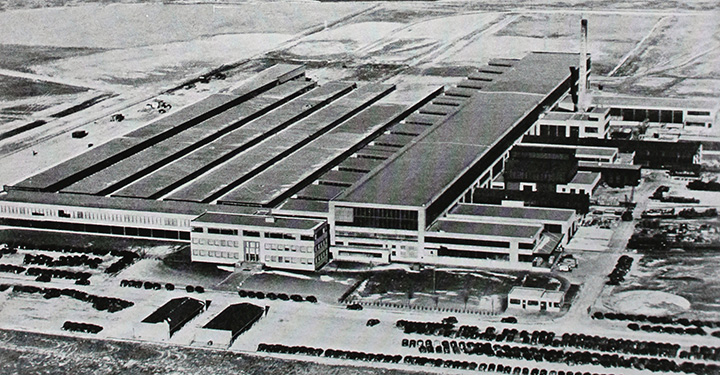
The EMD plant in LaGrange, IL just before
WWII in 1938.
Electro-Motive Division of General Motors World War Two Products:
110 Foot Subchasers: (544) Pancake Diesel 16 cylinder 16-184A
Electro-Motive 1,200 hp for (243) 110 Foot Subchasers. The Pancake
engine replaced the heavier GM Cleveland Diesel 700 hp 8-268 engines and
increased top speed from 17 to 22 knots. This does not include any spare
engines. This was the only application of the pancake engine, due
to apparently frequent engine rebuilds and maintenance.
LSTs (Landing Ship, Tanks): Electro-Motive provided two
12-567 900 hp diesel engines for 525 LSTs. EMD
was one of the two manufacturers supplying engines for this ship. Fairbanks-Morse
supplied the other engines for the remaining 525 LSTs.
180 Foot PCE (Patrol Craft Escort):
(136) 12-567 900hp for engines 68 ships built with two engines
each.
Research indicates all 68 ships had the EMD engines.
Army DPC 86 foot Tugboats: (100)
8-567 Diesel Engines. Each tugboat had one engine and the DPC
stood for Defense Plant Corporation that ordered not only the tugboats
but barges and towboats for its use. Once the tugboats were
finished DPC found it did not need them as planned and many were turned
over to other organizations. Five went to the US Navy as YTs, (27)
went to the War Shipping Administration as WSAs and (21) went to the US
Army as STs.
LCI(L) (Landing Ship, Infantry (Large)):
(1,098) sets of reduction gears, propellers, drive shafts and
control units. Detroit Diesel built the Quad Four engine which
consisted of four twin 6-71 tank engines assembled into a single unit.
Two Quad Fours were supplied for each LCI(L).
Generators: (967) Delco Products
Division of GM 100KW generators for for uses on US Navy Landing Craft.
This work was taken over from Delco Products and the contract was
completed by mid 1943.
Locomotives:
Information available is inconsistent. EMD did build
locomotives during the Second World War to assist in the transportation
of war production. At the end of 1940 there were 617 EMD
locomotive units in service. At the end of 1942 there were 1,115
units in service giving a production of 498 for 1941 and 1942. No
information has been found on 1943 but in 1944 EMD produced 500
locomotives and had a production goal of 72 units per month or 864 per
year. This would take total units produced through 1943 to
1,615. The final data point is that as of 7-31-1947 there were
3,238 locomotives in service or 2,621 units produced from 1941 through
the middle of 1947.
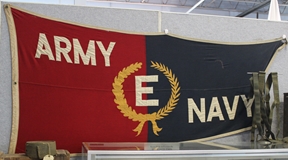
Electro-Motive won the Army-Navy "E" Award five times during
World War Two.
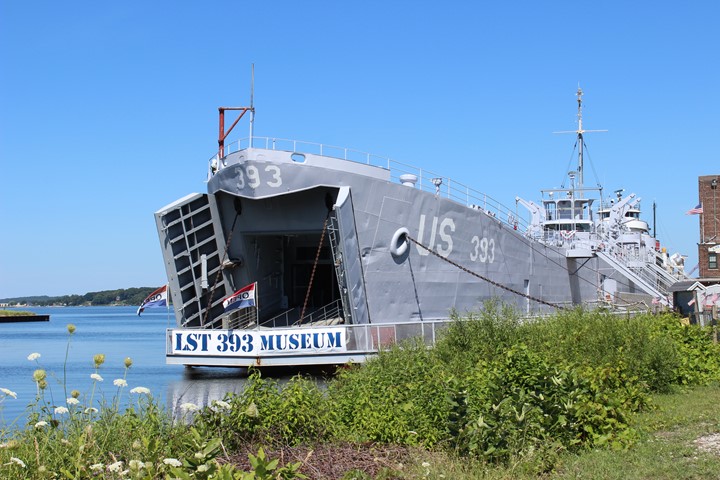
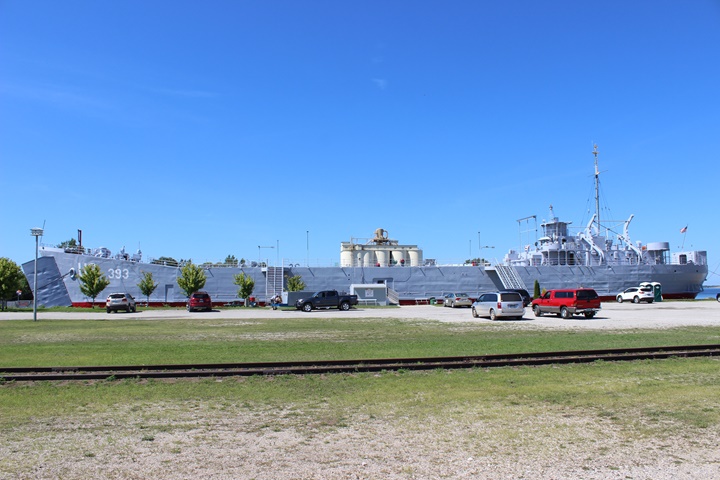
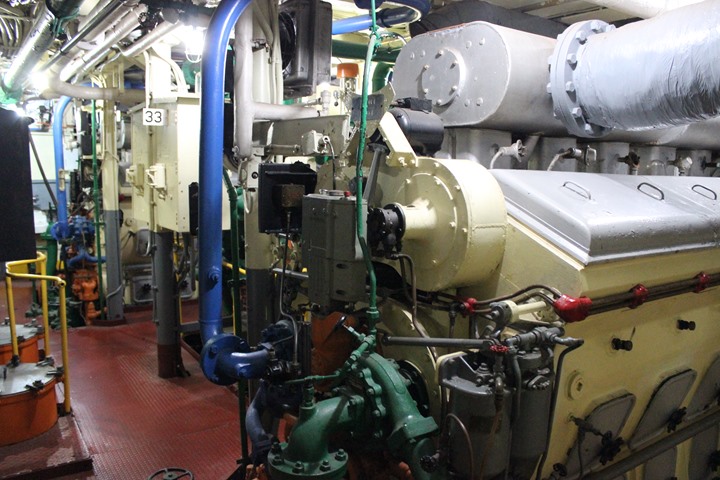
Inside the engine room of LST-393 are two
Electro-Motive 12-567ATLP/S (P=Port Engine and S=Starboard Engine) 900
BHP diesel engines. Both were built in 1942 when LST-393 was
constructed. This photo as the port engine nearest to the camera.
The starboard engine can be seen in the background.
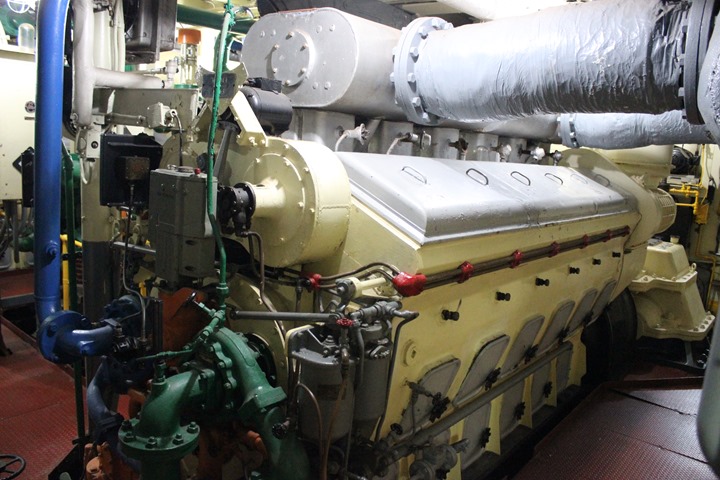
The port engine.
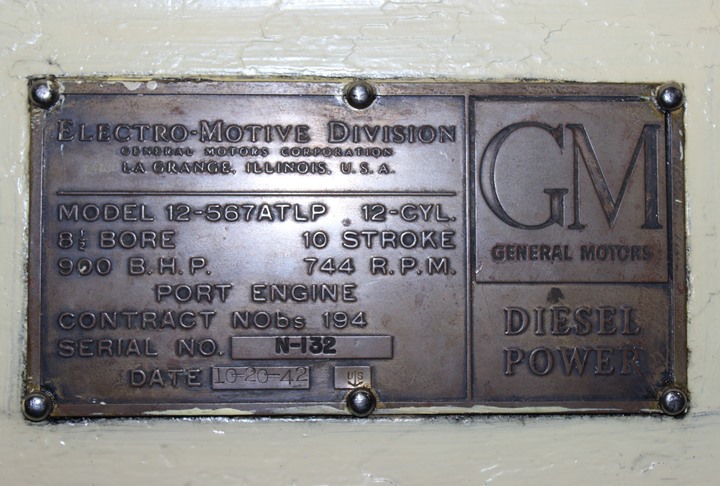
The original data tag on the Electro-Motive
port engine on LST-393. The model number 12-567 indicates that the
engine has twelve cylinders, each on displacing 567 cu. in. or 6,804 cu.
in. of total engine displacement. Serial number N-132 was built on
October 20, 1942.
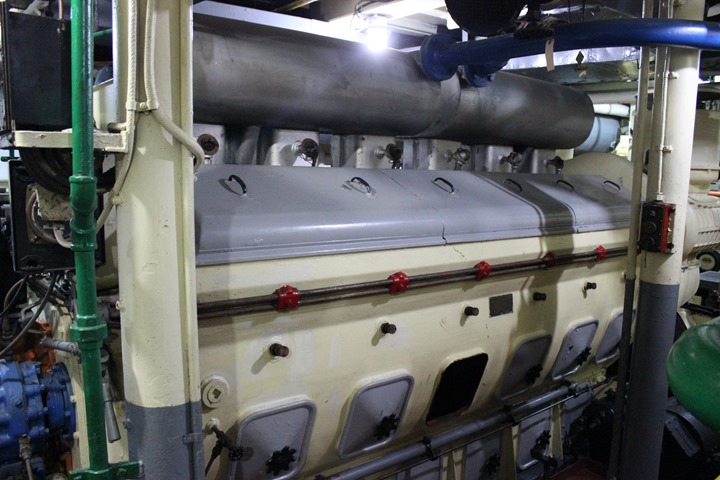
The starboard Electro-Motive engine on
LST-393. The engine was designed to be accessible to work on while
on the ship. The gray painted panels all give access to internal
engine components.
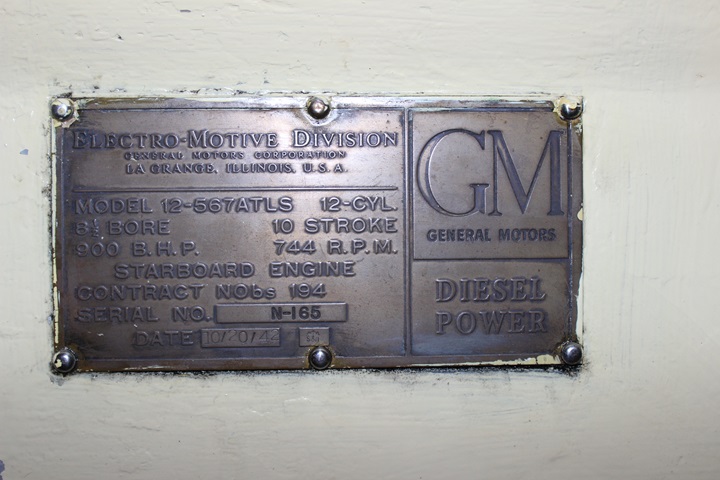
The starboard engine on LST-393 was also
built on October 20, 1942 and is serial number N-165. The model
number for this engine is 12-567ATLS. If one figures on the volume
of one cylinder, which is (3.14)(4.25**2)(10), one arrives at 567 cubic
inches.
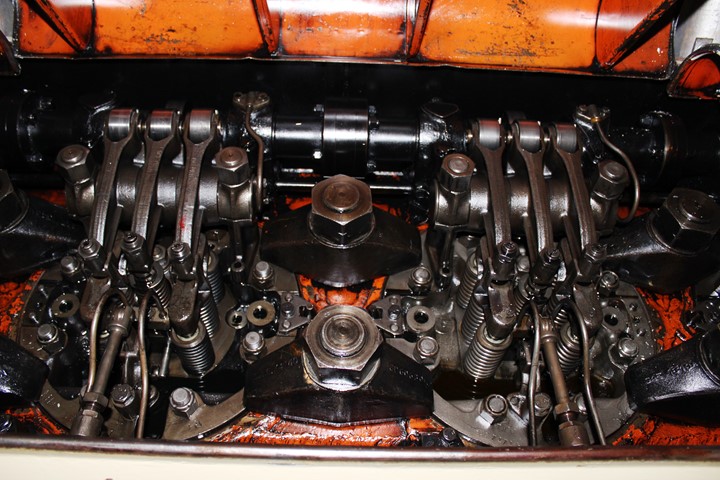
The valve covers can be lifted up and the
valve train examined and worked on.
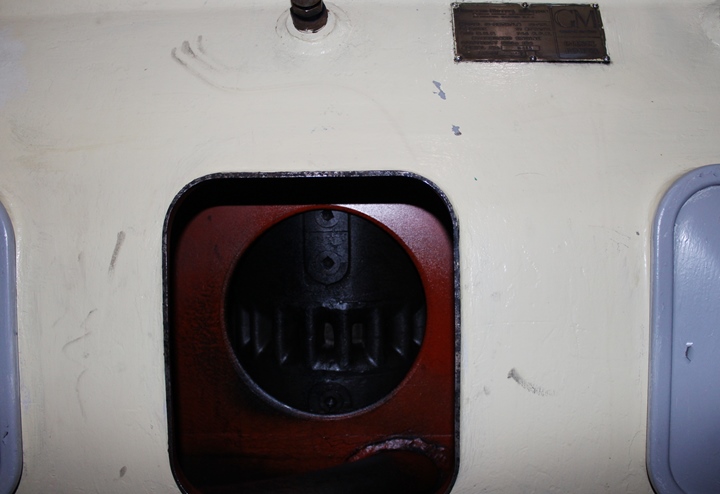
The open shows access to the piston inside
the engine.
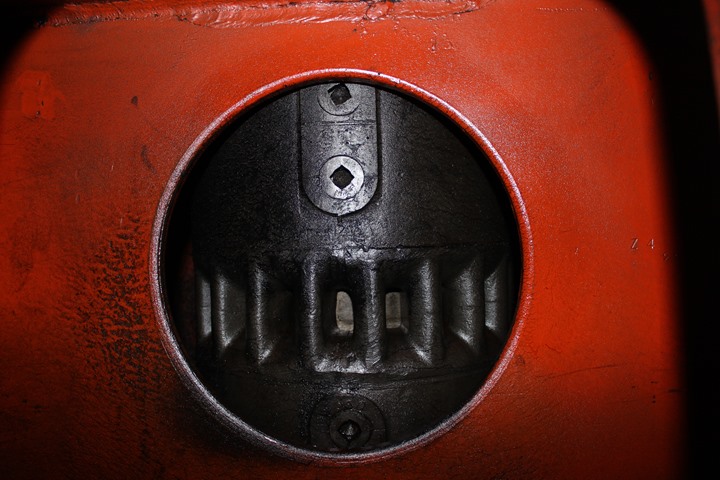
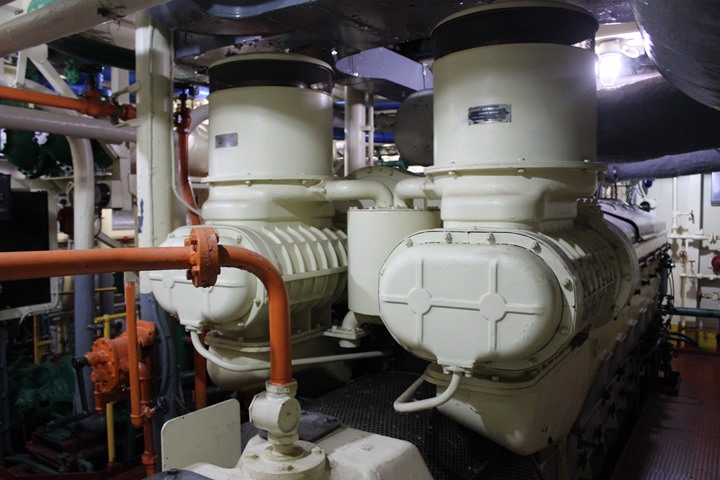
This photo looks at the starboard engine
from the output end. Each side of the engine has an air intake,
filter and supercharger.
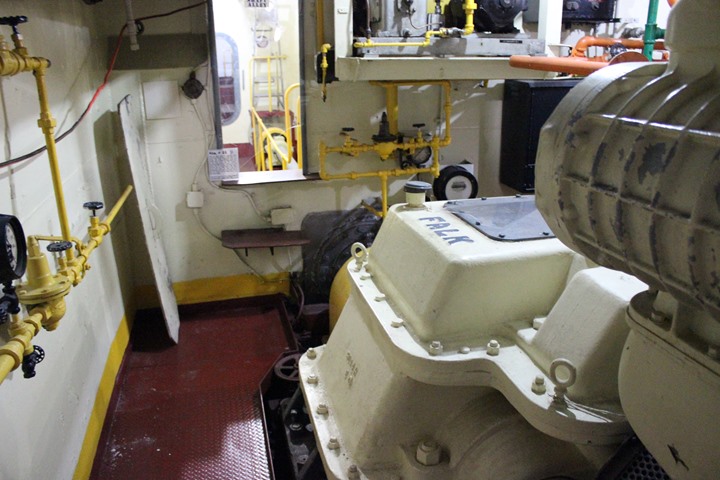
This photo was taken standing next to the
supercharger and looking back at the gear Falk gear reduction unit and
the propeller shaft in the background.
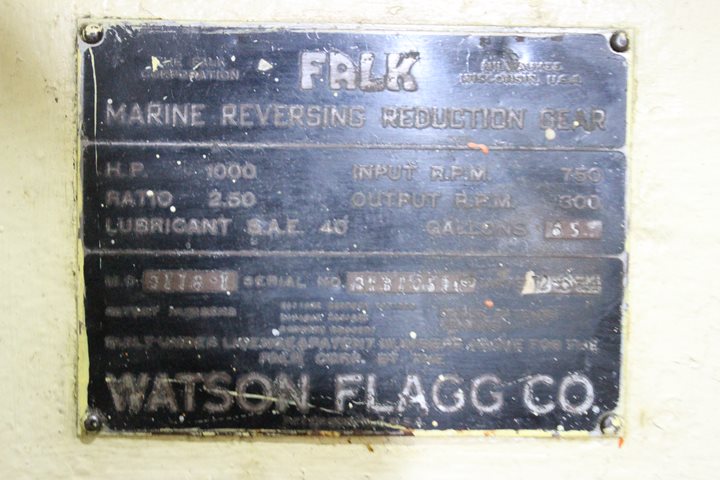
In the LST the EMD 12-567 was connected to
the propeller with a Falk Marine Reversing Reduction Gear. This
reduced the higher output speed of the engine to one more suitable for
the propeller speed. It also allowed the propeller to run in
reverse. This was especially important when the LST needed to back
off the beach.
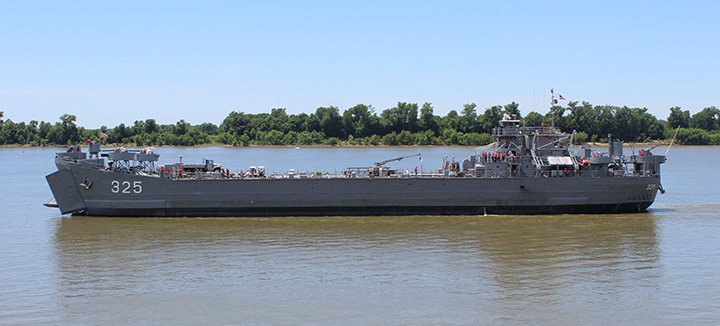
LST-325 is another one of the approximately 525
Landing Ship Tanks built during WWII that came equipped with two 12-567
900 hp Electro-Motive diesel engines. LST-325 is the last LST
still operating and she is seen here on the Ohio River in 2014.
Author's photograph added 10-12-2015.
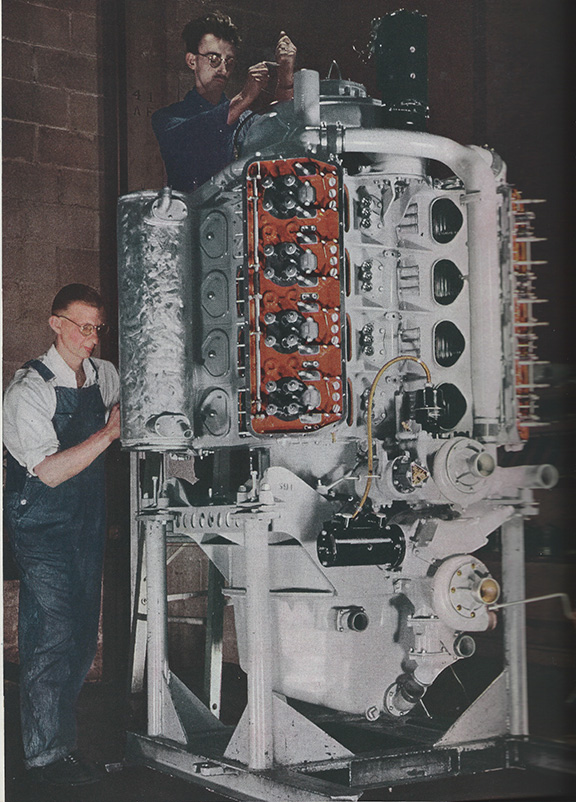
The Pancake engine under construction at EMD
during WWII. Output came out at a right angle to the engine at the
bottom.
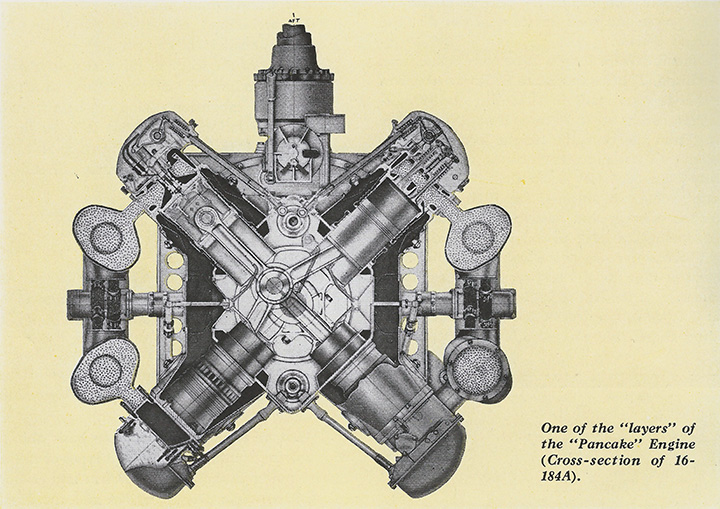
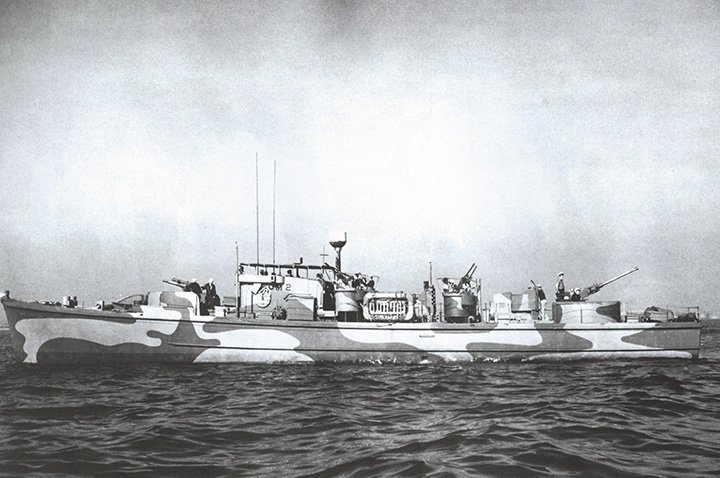
A 110 foot Subchaser during WWII which was
powered by two EMD Pancake engines.
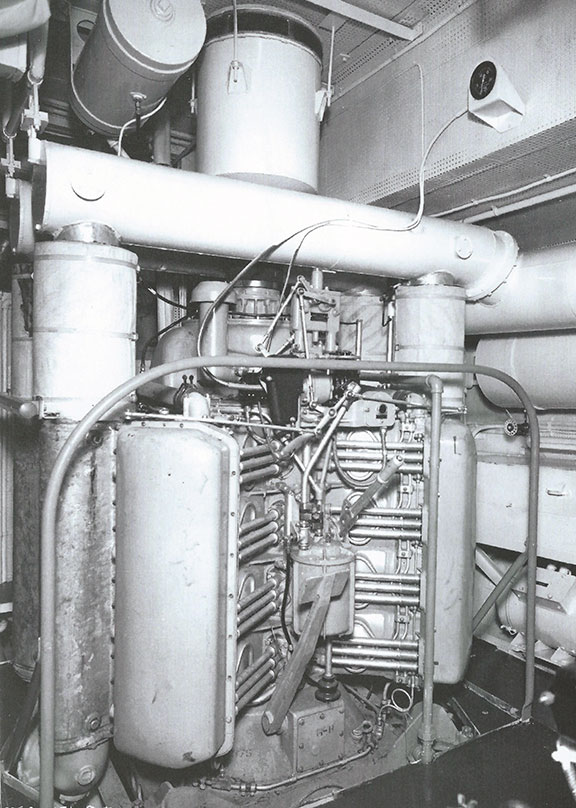
The EMD 16 cylinder 184A Pancake Engine in a
110 foot Subchaser's engine room.
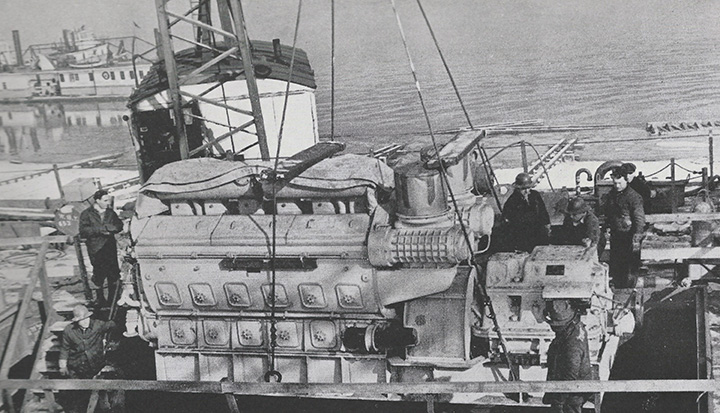
Here an EMD 12-567 900 hp diesel engine is
being installed in an LST during WWII.
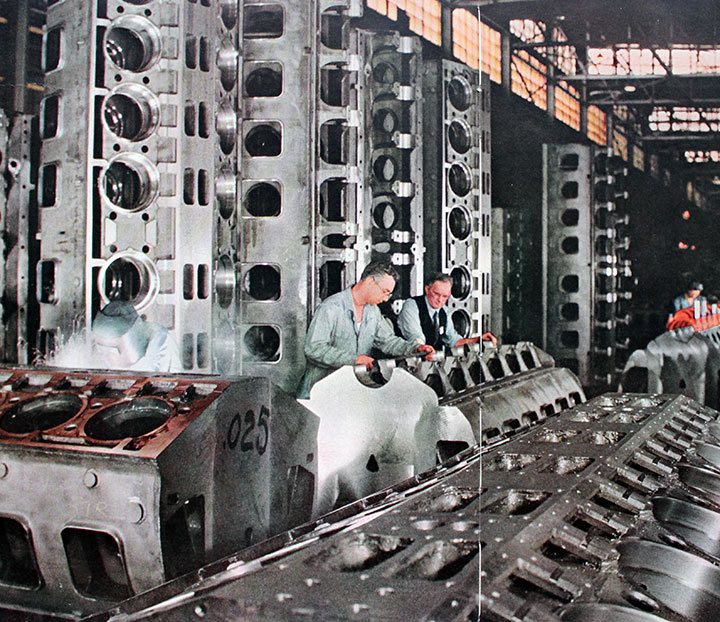
EMD 12-567 900 hp diesel engine blocks being
worked on during WWII.
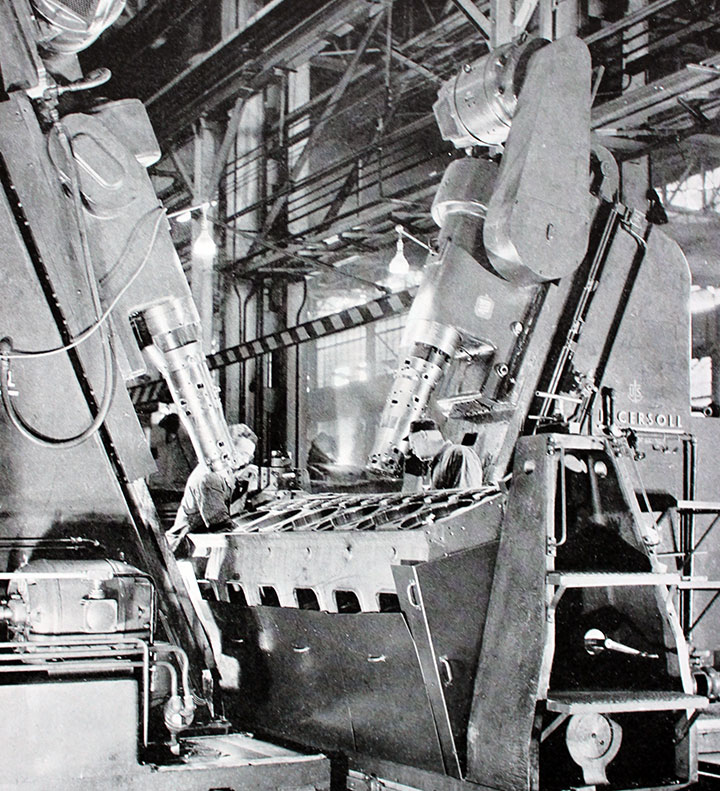
Here an EMD 12-567 engine block is being
machined.
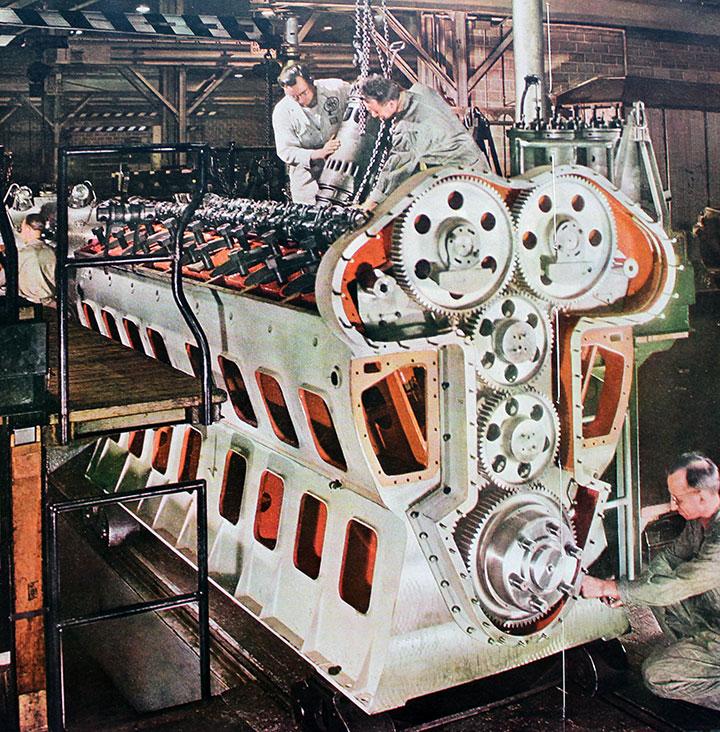
Final assembly of a
EMD 12-567 in LaGrange, IL during WWII.
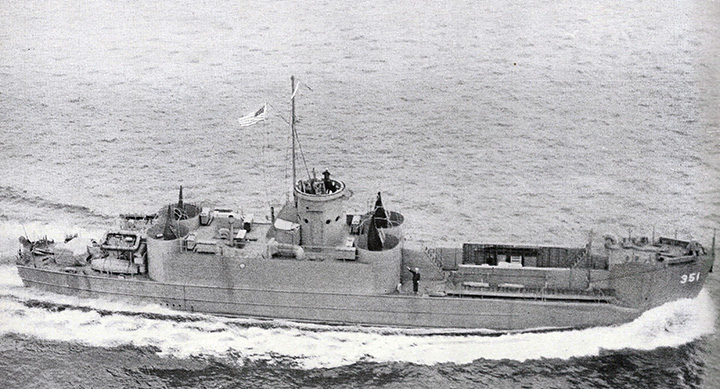
A US Navy LCI(L) (Landing Ship, Infantry
(Large)) underway during WWII with EMD supplied reduction gears,
propellers, drive shafts and control units.
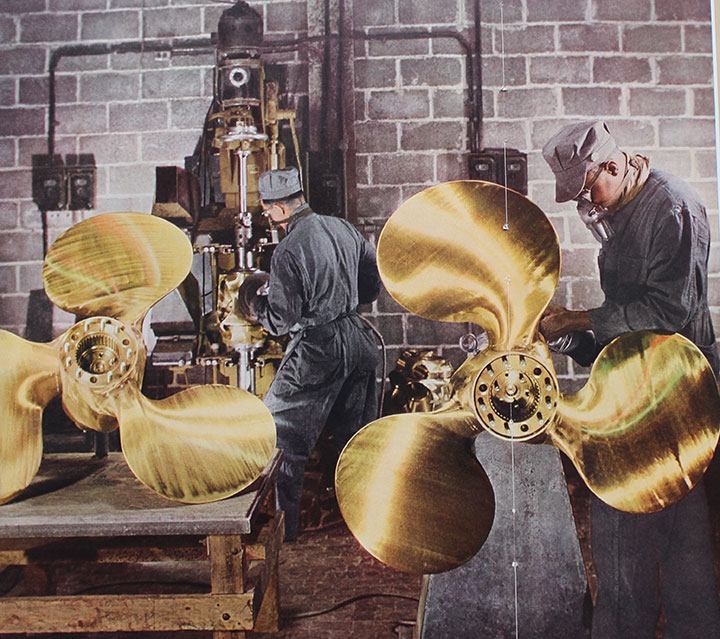
Final balancing and polishing of the LCI(L)
propellers by EMD workers during WWII. EMD supplied 2,190 brass
propellers like this for the landing craft.
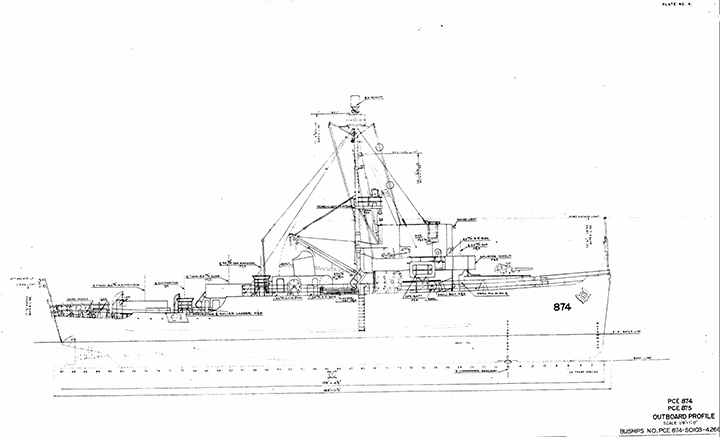
An outline drawing of a 180 foot Patrol
Craft Escort.

This drawing the 180 foot PCE shows the
location of the two EMD 12-567 900hp diesel engines.
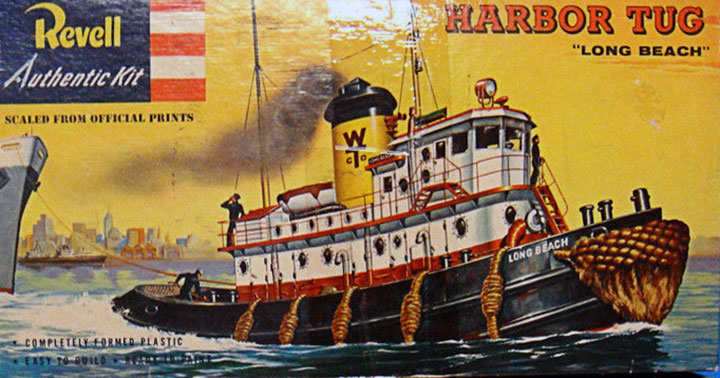
It turns out as a boy growing up in the late
fifties, I built the Harbor Tug "Long Beach" after receiving it as
either a birthday or Christmas present. It turns out the "Long
Beach" was built in Decatur, AL in 1944 as DPC 68 with an EMD 8-567
Diesel Engine. It was then turned over to the War Shipping
Administration as WSA 26 and then sold as surplus in 1946.
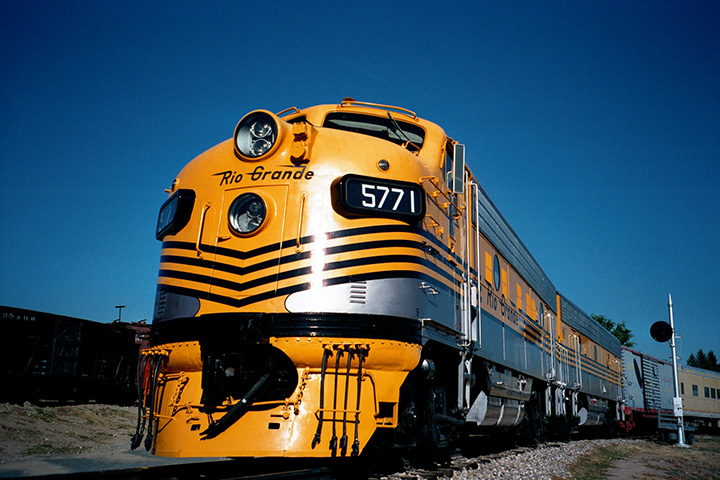
This a 1955 EMD F unit which is very similar
to the World War Two era FT units it produced. Author's photo at
the Colorado Railroad Museum.
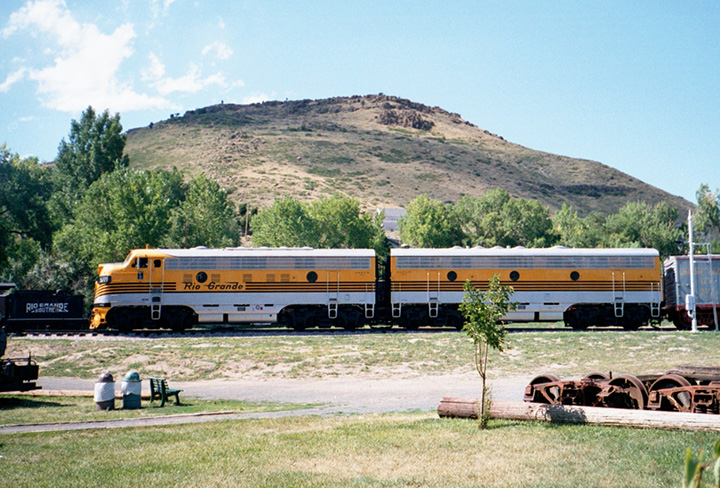
This photo shows better both the cab
and cabless booster units. Author's photo at the Colorado Railroad
Museum.
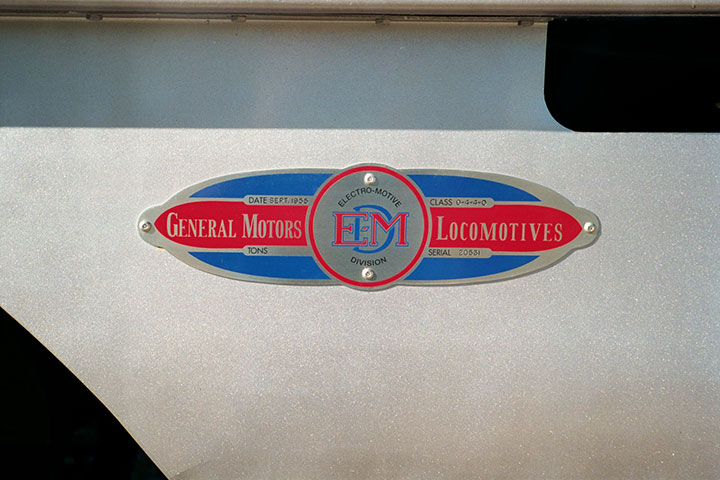
This not only shows it is a 1955 model
but more important the EMD name tag. Author's photo at the
Colorado Railroad Museum.
|































